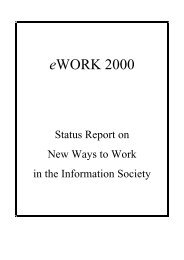Proceedings of 8th European Assembly on telework (Telework2001)
Proceedings of 8th European Assembly on telework (Telework2001)
Proceedings of 8th European Assembly on telework (Telework2001)
You also want an ePaper? Increase the reach of your titles
YUMPU automatically turns print PDFs into web optimized ePapers that Google loves.
164Many potentials for extending services to other parts <str<strong>on</strong>g>of</str<strong>on</strong>g> the labour market process (which could alsosupport those who exclusively work <strong>on</strong> the web, as eLancers do) have not been exploited yet. Onlya very few freelancer/project exchanges have set out to support the whole labour market process <strong>on</strong>an Internet-based platform, including the interacti<strong>on</strong> between worker and employer/client (whichin traditi<strong>on</strong>al employment relati<strong>on</strong>ships is usually dealt with by co-locati<strong>on</strong>). Examples includewww.smarterwork.com and www.elance.com. Here, trading partners need to agree <strong>on</strong> a cleardescripti<strong>on</strong> <str<strong>on</strong>g>of</str<strong>on</strong>g> the work product in advance. This seems to limit the applicability <str<strong>on</strong>g>of</str<strong>on</strong>g> integratedvirtual labour markets to niches (such as translati<strong>on</strong>, website programming, design). There remainsthe possibility that trends in the labour market (towards more outsourcing and an increasein self-employment in certain segments) will benefit integrated, Internet-based labour markets.If employment c<strong>on</strong>tracts become ‘unbundled’, these kind <str<strong>on</strong>g>of</str<strong>on</strong>g> advanced exchanges might gainc<strong>on</strong>siderably in importance. Today and in the foreseeable future, however, they will be <str<strong>on</strong>g>of</str<strong>on</strong>g> negligiblesignificance for the overall labour market.Our case study research outlined in Secti<strong>on</strong> 2 has already shown that there are still powerfulbarriers that prevent labour from becoming a product that can be traded like goods <strong>on</strong> electr<strong>on</strong>icmarkets. In the last part <str<strong>on</strong>g>of</str<strong>on</strong>g> this paper, we ask whether general trends <strong>on</strong> the labour market supportor refute the hypothesis that the properties <str<strong>on</strong>g>of</str<strong>on</strong>g> eLancing are becoming comm<strong>on</strong>-place in EU labourmarkets.4 Is eLancing Becoming a Mainstream Model for Work Organisati<strong>on</strong>?The current number <str<strong>on</strong>g>of</str<strong>on</strong>g> self-employed freelancers who might be described as eLancers is very hardto measure for lack <str<strong>on</strong>g>of</str<strong>on</strong>g> a clear operati<strong>on</strong>alisati<strong>on</strong>. ‘Free agents’, which many regard as a preliminarystage in the development towards eLancing (Laubacher and Mal<strong>on</strong>e 2000), are believed to accountfor 30% <str<strong>on</strong>g>of</str<strong>on</strong>g> the US labour force (Kelly Services 1999), but mostly these numbers are derived at bysimply counting all those that work in atypical forms <str<strong>on</strong>g>of</str<strong>on</strong>g> employment. Similarly Pink (1997) addsup the self-employed, the independent c<strong>on</strong>tractors and temporary workers and arrives at a number<str<strong>on</strong>g>of</str<strong>on</strong>g> 25 milli<strong>on</strong> free agents, 16% <str<strong>on</strong>g>of</str<strong>on</strong>g> the US workforce. Is it appropriate to assume that all <str<strong>on</strong>g>of</str<strong>on</strong>g> theseworkers will become eLancers in the near future, acting as precursors <str<strong>on</strong>g>of</str<strong>on</strong>g> a general shift towardseLancing which will encompass large parts <str<strong>on</strong>g>of</str<strong>on</strong>g> the labour force?Evidence collected by empirica through a set <str<strong>on</strong>g>of</str<strong>on</strong>g> representative surveys in 1999 suggests otherwise(Gareis 2001): Although the share <str<strong>on</strong>g>of</str<strong>on</strong>g> <strong>telework</strong>ers am<strong>on</strong>g the self-employed is c<strong>on</strong>siderably highercompared to the total workforce (almost 30% <str<strong>on</strong>g>of</str<strong>on</strong>g> all <strong>telework</strong>ers are self-employed, against <strong>on</strong>ly17% <str<strong>on</strong>g>of</str<strong>on</strong>g> all n<strong>on</strong>-<strong>telework</strong>ers), the large majority <str<strong>on</strong>g>of</str<strong>on</strong>g> the self-employed still rely <strong>on</strong> traditi<strong>on</strong>alcommunicati<strong>on</strong> media for reaching their clients and for collaborating with business c<strong>on</strong>tacts. Evenexcluding workers in the primary sector, the shares <str<strong>on</strong>g>of</str<strong>on</strong>g> workers who tele-cooperate regularly orat least occasi<strong>on</strong>ally are substantially lower am<strong>on</strong>g the self-employed then am<strong>on</strong>g the total workforce (see Table 2) with the excepti<strong>on</strong> <strong>on</strong>ly <str<strong>on</strong>g>of</str<strong>on</strong>g> Denmark and (to some extent) the Netherlands. Telecooperati<strong>on</strong>with external workers is more widespread am<strong>on</strong>g employees working in companiesthan am<strong>on</strong>g the self-employed (!), although the latter have more external c<strong>on</strong>tacts with clients andcustomers.2 excluding workers in primary sector








